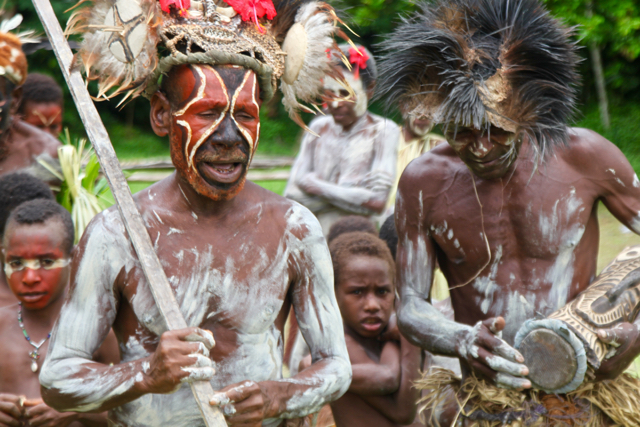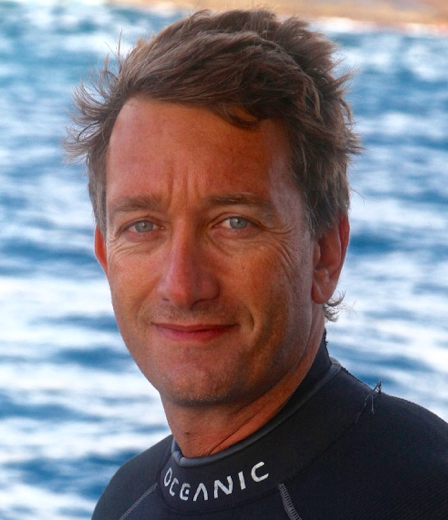
For centuries, cannibalism was not only part of tribal life in Papua New Guinea but a central part of religion.
When European colonialists arrived in the late 19th century, cannibalism was outlawed. The last part of PNG where it was openly practised was also one of the most remote – East Sepik Province, a floodplain dominated by the Sepik River, PNG’s largest river and one of the world’s largest river systems.
The last reported case of cannibalism in the Sepik was in 1964 when a group of men raided a neighbouring village for meat – as their ancestors had for thousands of years. All seven offenders were hanged by “kiaps” – Australian patrol officers who were the law of the land until PNG’s independence in 1975.
Most kiaps left the Sepik after independence. It is, after all, a malarial swamp. But one, John Pasquarelli, took such a liking to the place he stayed on and built a lodge to share the raw, wild beauty and unique culture of the Sepik River with travellers and like-minded souls.

Villagers perform at a festival in East Sepik. Photo: AAP
Planes, jet boats and troop carriers
My journey to the Sepik begins in Mount Hagen, the PNG highlands’ largest city, where I board a nine-seater plane. The scenery on the 45-minute flight to the Sepik is insane – a magazine of dramatic valleys, fast-flowing rivers, glacial peaks and forested escarpments. It must be one of the most scenic flights on Earth.
The moment we touch down, I am attacked by mosquitos – with a ferocity their fellows elsewhere exhibit only at dusk. The insects do not leave me alone for the duration of the stay. It is dog eats malaria-infested dog in the Sepik. Only the strongest survive.
From the airstrip, a path leads through the sweltering jungle to a jetty where I board a flat-bottomed jet boat for the journey to the Karawari River, a tributary of the Sepik.
After 10 minutes we arrive at Karawari Lodge, where a final scramble in a troop carrier up an incline with foot-deep muddy ruts takes me to the front door. There, uniformed attendants offer a chilled towelette and fresh guava juice before leading me to my room – a stilt bungalow with 180-degree river, jungle and mountain views. There is usually electricity from 6am-10pm, although it cuts out half a dozen times a day.

The view from Karawari Lodge.
Lunch is served in the main lodge. A long room inspired by the local “spirit haus”, where river chiefs once displayed skulls of vanquished foes, it is filled with the hand-carved ceremonial masks and totem poles the Sepik is renowned for. Today’s menu features homemade pumpkin soup with fresh-baked bread, barramundi with lemon and herb sauce and date pudding – washed down with South Australian sauvignon blanc.
“Everything you see on the table, from the plates, to the salt, to the butter had to be flown in by us,” Toronto-born general manager Nick Kosonic says. “It’s an incredible logistical feat running a place of this standard the middle of nowhere. Everything here is a challenge – one the biggest challenges I’ve faced in my life.”
Cooking class
After lunch, I return to the jet boat for a romp along the river with my guide, Sepik man Paul Api. “This afternoon we will go to Kundiman 2,” he says. “Originally it was part of another village that is now called Kundiman 1, but it grew too big and they had a hard time feeding everyone so they split the village in half.”
Kundiman 2 is a few minute’s from the lodge but might as well be on the other side of the moon. There’s no power, no jetty, no amenities – just a collection of hardscrabble stilt huts in a clearing on the river bank. The women are topless, wearing only skirts made of pandanus leaves. The men wear dirty old pants or shorts, while the children – of which there are legions – are naked. Many have bloated stomachs from the intestinal tapeworms they get from drinking the river water.
A post shared by Simon Heyes – Travel Blogger (@mrheyes) on
The villagers put on a sago-making demonstration (sago is a starch extract from a palm tree of the same name). First, the bark is removed from a sago stump with two sticks, in the same way a mechanic would jimmy a tire from a wheel. The spongy pulp is chiselled out and taken to the river, where women squeeze out the starch with water and elbow grease.
When the pulp dries, it becomes sago flour and is fried as a pancake or combined with water for a gooey, semi-transparent porridge. River people eat sago as the base of every meal, accompanied by fish, greens and nuts from the jungle.
The pancake tastes quite rubbery, while the porridge is a bit hard to stomach. But seeing the effort that goes into harvesting and cooking it gives me plenty to think about later that night as I drift off to sleep listening to the noise of creatures trapping and consuming their dinner in the dark jungle.
The bloodstone
The next day we visit Konmei Village on the Konmei River. We’re treated to a victory dance once used to celebrate successful headhunts – the last vestige of the Sepik people’s not-so-distant cannibalistic past.
“When the Konmei warriors made plans to go out to hunt heads at night, they would put a triangular-shaped mask at the head of the canoe to let their enemies know it was war,” Paul says as villagers jump up and down, beat drums, chant, stamp their feet, sing and shout.
“If the hunt was successful, they would dress up and assemble in front of the spirit haus by the bloodstone,” he says, pointing to an angular rock sticking in the ground.

A traditional village hut on the Sepik River bank.
The dancers pick up speed and their voices rise, spiralling into a frenzy of colour, limbs and sound.
“Then the victims,” Paul says, shouting to be heard, “would have their heads cut off. Their blood would then be poured over the stone so they can tame the spirit of the dead. But the main way to pass on the power and knowledge of the victims was by making brain soup mixed with ginger, cinnamon and bark.”
The performance reaches a crescendo and comes to a heart-pounding end. The dancers are sweet-soaked and exhausted.
Back on the river, our driver steers us towards a forested bank where we land for lunch. Paul puts on a lavish spread but before we can swallow the first mouthful, mosquitos attack. We have no choice but to untie the jet boat and continue down the river, eating on the run.
Cannibalism might be a thing of the past in the Sepik but you can still get eaten alive.
Fact file
Getting there
PNG Air flies four times daily from Port Moresby to Mount Hagen. Return airfare starts at AU$500.
From Mount Hagen, Trans Niugini Tours will fly you to Karawari. Return airfares AU$660 per person.
Staying there
Room rates at Karawari Lodge, including board and tours, are AU$1600 per couple or twin share per night. Board on the Sepik Spirit, an air-conditioned luxury houseboat on the Sepik River, is AU$2000 per couple or twin share per night. See pngtours.com/lodge2.html
When to go
Karawari Lodge welcomes guests from March-December. The Sepik Spirit operates from April-November.
What to bring
Mosquito repellant and lots of it.
